Siemens RDF800KN Touch Screen Room Thermostats

INTRODUCTION
- KNX bus communications (S-mode and LTE mode)
- Large display with backlight
- 2P / PI / P control
- Outputs for ON/OFF or 3-position control
- Outputs for 3-speed or 1-speed fan
- 2 multifunctional inputs for keycard contact, external sensor, etc.
- Independent function for window contact and presence detector
- Operating modes: Comfort, Economy and Protection
- Automatic or manual fan speed control
- Automatic or manual heating / cooling changeover
- Minimum and maximum limitation of room temperature setpoint
- Control depending on the room or the return air temperature
- Adjustable commissioning and control parameters
- Commissioning with Synco ACS, ETS5 or via local HMI
- Interoperation into Synco 700
- Integration into Desigo via group (ETS5) or via individual addressing
- Integration into third-party system via group addressing (ETS5)
- AC 230 V operating voltage
- RDF800KN, RDF800KN/VB: Mounting on round box, with min 60 mm diameter or recessed square 86 mm box with 60.3 mm fixing centers and min 40 mm depth
- RDF800KN/NF: Mounting on recessed square 86 mm box with 60.3 mm fixing centers and min 40 mm depth, requires additional mounting frame
Use
Room temperature control (heating or cooling) in individual rooms and zones by means of:
- 2-pipe fan coil units
- 2-pipe fan coil units with electrical heater
- 4-pipe fan coil units
- Chilled /heated ceiling
- Chilled /heated ceiling and electrical heater
- Chilled ceiling and radiator / under floor heating
- Compressors in DX-type equipment
- Compressors in DX-type equipment with electrical heater
The RDF800KN… controls:
- One single or 3-speed fan
- One or two ON/OFF valve actuators
- One ON/OFF valve actuator and one 1-stage electrical heater
- One 3-position valve actuator
- One 1-stage compressor in DX-type equipment, or one 1-stage compressor with electrical heater
Used in systems with:
- Heating or cooling mode
- Automatic heating/cooling changeover
- Manual heating/cooling changeover
- Heating and cooling mode (such as 4-pipe system)
The room thermostats are delivered with a fixed set of applications. The relevant application is selected and activated during commissioning using one of the following tools:
- Synco ACS
- ETS5
- Local DIP switch and HMI
Functions
- Room temperature control via built-in temperature sensor or external room temperature / return air temperature sensor
- Changeover between heating and cooling mode (automatically via local sensor or bus, or manually)
- Selection of applications via DIP switches or commissioning tool
- Selection of operating mode via touch screen
- Temporary Comfort mode extension
- 1- or 3-speed fan control (automatically or manually)
- Display of current room temperature or setpoint in °C and/or °F
- Minimum and maximum limitation of room temperature setpoint
- Keylock function: unlock, total lock and setpoint
- 2 multifunctional inputs, freely selectable for:
- Window contact
- Presence detector
- External room temperature or return air temperature sensor
- Fault input
- Monitor input for temperature sensor or switch state
- Sensor for automatic heating / cooling changeover (RDF…)
- Dew point sensor (RDF…)
- Electric heater enable (RDF…)
- Advanced fan control function, such as: fan kick, fan start delay, and selectable fan operation (enable, disable or depending on heating or cooling mode)
Applications
The thermostats support the following applications, which can be configured using the DIP switches on the inner side of the thermostat’s front panel or a commissioning tool.
Remote configuration
All DIP switches need to be set to OFF (factory setting) to select an application via the commissioning tool.

Applications for fan coil systems
Applications for Universal systems
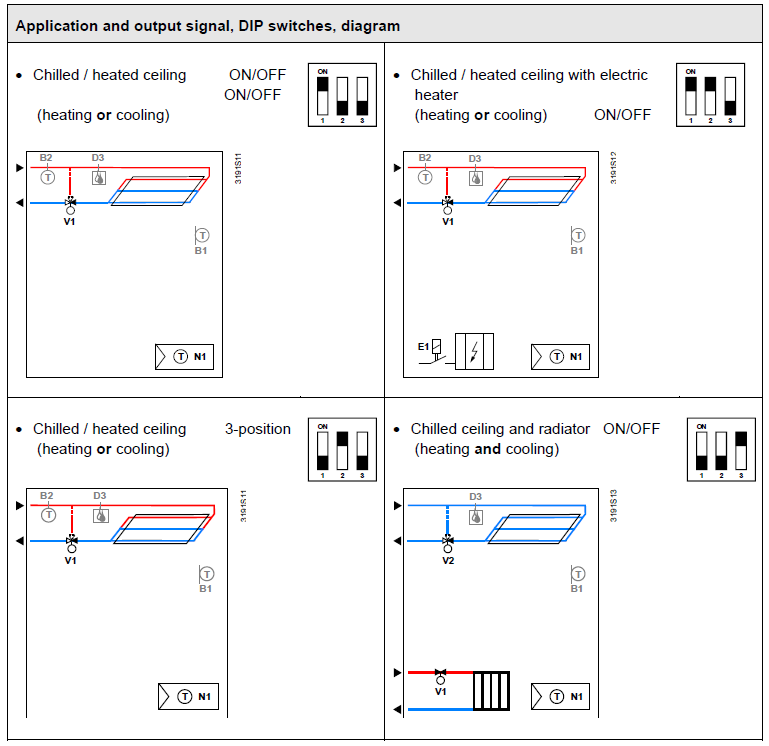
Applications for heat pump systems
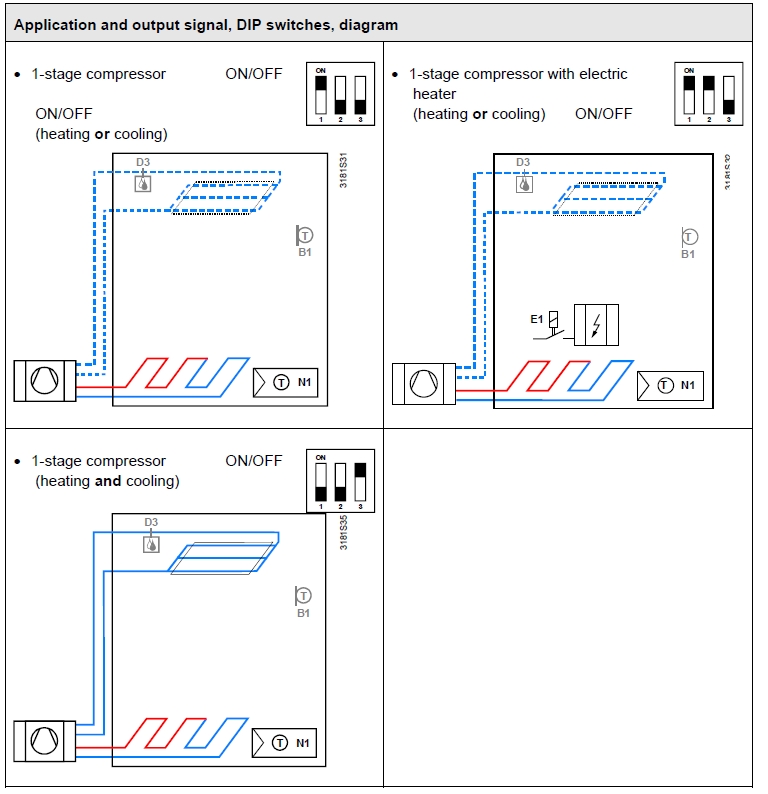
Type summary
|
Product no. |
Stock no. |
Operating voltage | Control outputs | Suitable conduit box |
Color |
|
| 3-pos | ON/OFF | |||||
| RDF800KN | S55770-T350 | AC 230 V | 1 1) | 2 1) | Round conduit box | White |
| RDF800KN/NF
2) |
S55770-T335 | AC 230 V | 1 1) | 2 1) | Square conduit box 2) | White |
| RDF800KN/VB | S55770-T429 | AC 230 V | 1 1) | 2 1) | Round conduit box | Black |
Ordering
- When ordering, indicate the product number, SSN and name.
- For example: RDF800KN/NF (S55770-T335) room thermostat
- RDF800KN (S55770-T350) room thermostat
- A mounting frame must be ordered for RDF800KN/NF installation (See “Accessories”).
- Order valve actuators separately
Equipment combinations
ON/OFF actuators
3-position actuators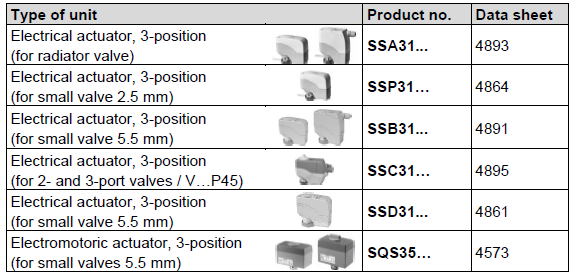
Accessories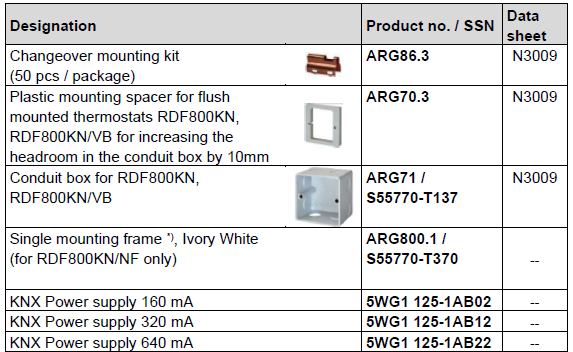
Mechanical design
The thermostats consist of the following parts:
- Front panel with electronics, operating elements and built-in room temperature sensor.
- Mounting base with power electronics.
- Mounting frame is an additional part to complete the installation for RDF800KN/NF.
- The rear of the mounting base contains the screw terminals.
- Slide the front panel in the mounting base and snap on.
Operation and settings
Display

Engineering notes
See the “Reference documentation”, page 15, for information on how to engineer the KNX bus (topology, bus repeaters, etc.) and how to select and dimension connecting cables for supply voltage and field devices.
Mounting and installation
Mount the room thermostat on a conduit box. Do not mount on a wall in niches or between bookshelves, behind curtains, above or near heat sources, or exposed to direct solar radiation. Mount about 1.5 m above the floor
Mounting / Dismounting
- Do not apply excessive force on screws! The deformation of the mounting frame may lead to improper connections and the operation of the unit.
- Mount the room thermostat on a clean, dry indoor place without direct airflow from a heating/cooling device, and not expose to drips or splashes water.
- For RDF800KN, RDF800KN/VB only, in case of limited space in the conduit box, use the mounting spacer ARG70.3 to increase the headroom by 10mm.
- Before removing the front cover, disconnect the power supply
Wiring
- See the User Manual for the installation instructions enclosed with the thermostat.
- Comply with local regulations to wire, protection and earth the thermostat.
- The device has no internal fuse for supply lines to fan and actuators. To avoid risk of fire and injury due to short-circuits, the AC 230 V mains supply line must have a circuit breaker with a rated current of no more than 10 A.
- Properly size the cables to the thermostat, fan and valve actuators for AC 230 V mains voltage.
- Use only valve actuators rated for AC 230 V.
- The wiring cross section used for power supply (L, N), fan / relays (Qx) and 230 V outputs (Yx – N) must be adapted to the preceding overload protection elements (max 10A) under all circumstances. Comply under all circumstances with local regulations.
- Cables of SELV inputs X1-M / X2-M: Use cables with min 230 V insulation, as the conduit box carries AC 230 V mains voltage.
- Inputs X1-M or X2-M: Several switches (e.g. window contact) may be connected in parallel. Consider overall maximum contact sensing current for switch rating.
- KNX communication cables (input CE+ / CE-): Use cables with min 230 V insulation, as the conduit box carries AC 230 V mains voltage.
- When a KNX bus power supply is connected on the line with communicating thermostats and Synco controllers, the internal KNX power supply of the Synco controllers must be switched off.
- No cables provided with a metal shield.
- Disconnect from supply before opening the cover
Commissioning notes
Before power up
Set DIP switches to select the desired application before power up:
- For remote setup via commissioning tools, set all DIP switches to OFF (see “Remote configuration” for more details);
- For local setup, set DIP switches to select applications (refer to the following table).

Wizard
After DIP switches are selected and the thermostat is powered up, the wizard function guides users to configure the basic parameters for normal operation according to the table below.
- Touch
 to advance / return to any parameter;
to advance / return to any parameter; - Touch + / – to change value.
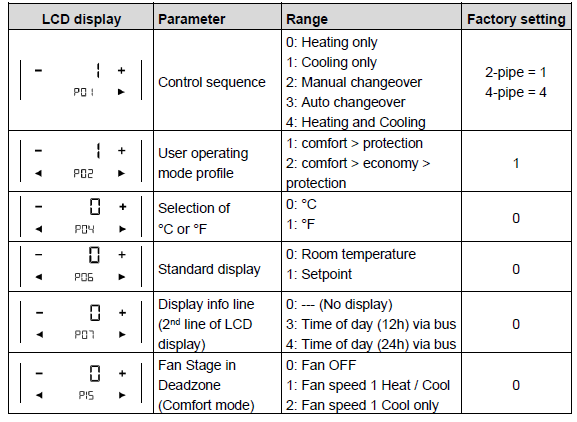
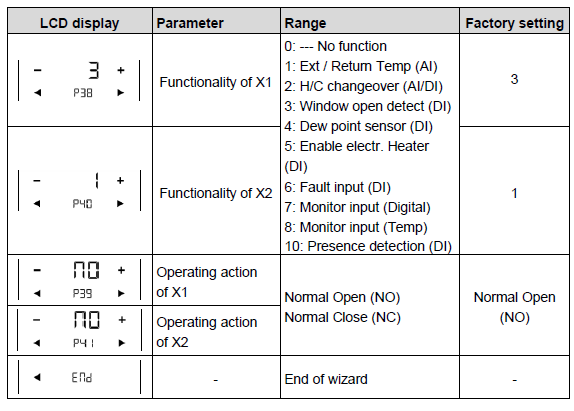
Reset
To re-load factory settings for all parameters, set parameter P71 to ON. Restart the thermostat manually after reset, and then the thermostat is ready for commissioning by qualified HVAC staff
Applications
The room thermostats are delivered with a fixed set of applications. Select and activate the relevant application during commissioning using one of the following tools:
- Local DIP switch and HMI
- Synco ACS
- ETS5
Connect tool
Connect the Synco ACS or ETS5 tools to the KNX bus cable at any point for commissioning: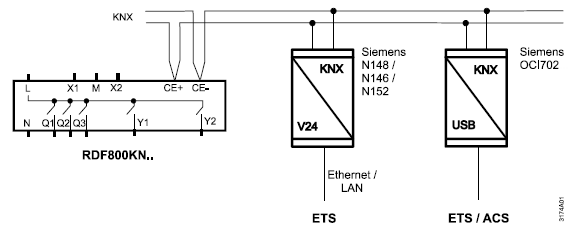
ACS and ETS5 require an interface:
- Ethernet/LAN KNX interface (such as Siemens N148 / N146 / N152)
- OCI702 USB – KNX interface
Control parameters
The thermostat’s control parameters can be set to ensure optimum performance of the entire system (refer to basic documentation P3174). The parameters can be adjusted using
- Local HMI
- Synco ACS
- ETS5
Control sequence
The control sequence may need to be set via parameter P01 depending on the application. The factory setting for the 2-pipe application is “Cooling only”; and “Heating and Cooling” for the 4-pipe application
Compressor-based application
When the thermostat is used with a compressor, adjust the minimum output ontime (parameter P48) and off-time (parameter P49) for Y1 / Y2 to avoid damaging the compressor or shortening its life due to frequent switching
Calibrate sensor
Recalibrate the temperature sensor if the room temperature displayed on the thermostat does not match the room temperature measured (after min. 1 hour of operation). To do this, change parameter P05
Setpoint and range limitation
We recommend to review the setpoints and setpoint ranges (parameters P08…P12) and change them as needed to achieve maximum comfort and save energy.
Programming mode
The programming mode helps identify the thermostat in the KNX network during commissioning. Touch and hold![]() for more than 5 seconds to activate programming mode, which is indicated on the display with Pr09. Programming mode remains active until thermostat identification is complete
for more than 5 seconds to activate programming mode, which is indicated on the display with Pr09. Programming mode remains active until thermostat identification is complete
Assign KNX device address
Assign device address (P81) via HMI, ACS or ETS5. With device address set to 255, the communication is deactivated (no exchange of process data).
Assign KNX group addresses
Use ETS5 to assign the KNX group addresses of the RDF communication objects.
KNX serial number
Each device has a unique KNX serial number inside the front panel. An additional sticker with the same KNX serial number is enclosed in the packaging box. This sticker is intended for installers for documentation purposes
Disposal
The device is considered electrical and electronic equipment for disposal in terms of the applicable European Directive and may not be disposed of as domestic garbage.
- Dispose of the device through channels provided for this purpose.
- Comply with all local and currently applicable laws and regulations.
Technical data
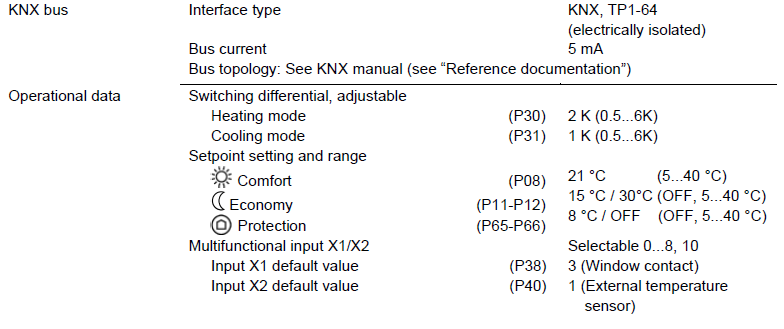
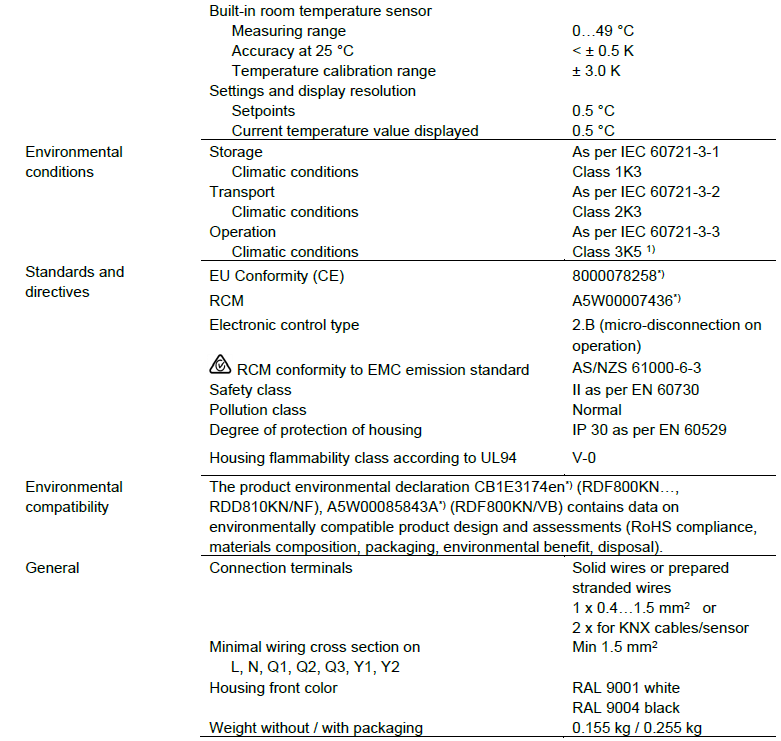

Connection terminals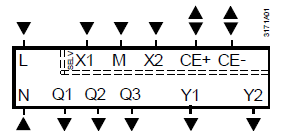
- LN Operating voltage AC 230 V
- Q1 Control output “Fan speed 1 AC 230 V”
- Q2 Control output “Fan speed 2 AC 230 V”
- Q3 Control output “Fan speed 3 AC 230 V”
- Y1,Y2 Control output “Valve” AC 230 V (N.O., for normally closed valves), output for compressor or output for electrical heater
- X1, X2 Multifunctional input for temperature sensor (such as
- QAH11.1) or potential-free switch
Factory setting:
- X1 = Window contact
- X2 = External sensor (function can be selected via parameter P38 / P40)
- M Measuring neutral for sensor and switch
- CE+ KNX data +
- CE- KNX data –
Connection diagrams
- N1 Room thermostat RDF800KN…
- M1 1- or 3-speed fan
- V1 Valve actuator, 2- or 3-position
- V1, V2 Valve actuator, 2-position
- E1 Electric heater
- C1, C2 1-stage compressor
- S1, S2 Switch (keycard, window contact, presence detector, etc.)
- B1, B2 Temperature sensor (return air temperature, external room temperature, changeover sensor, etc.)
- CE+ KNX data +
- CE- KNX data –
Dimensions (mm)
RDF800KN/NF for square conduit boxes only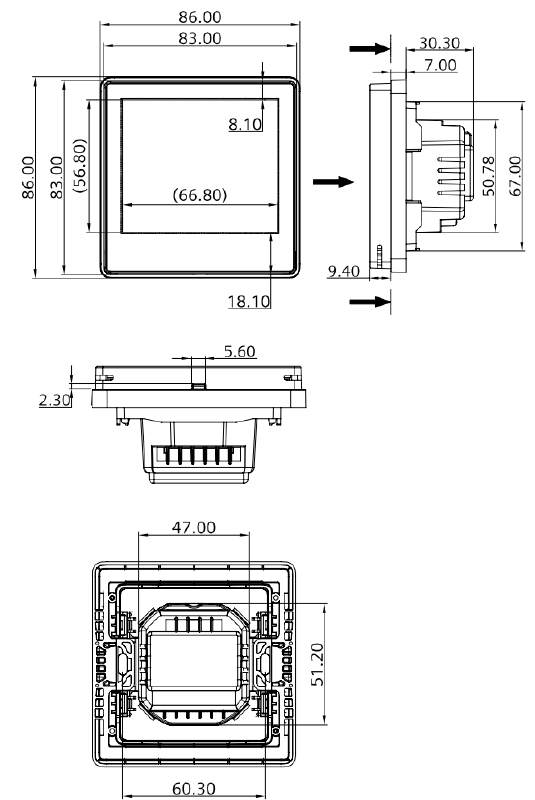
RDF800KN, RDF800KN/VB for round conduit boxes

ARG800.1 single mounting frame for RDF800KN/NF
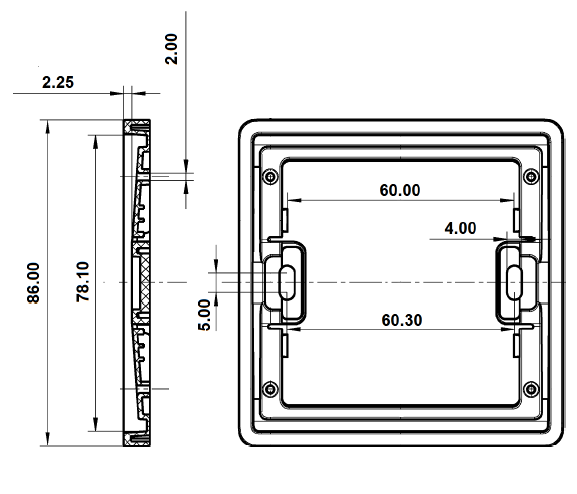
Issued by
- Siemens Switzerland Ltd.
- Building Technologies Division
- International Headquarters
- Theilerstrasse 1a
- CH-6300 Zug
- Tel. +41 58 724 2424
- www.siemens.com/buildingtechnologies
REFERENCE:
DOWNLOAD MANUAL:
Siemens RDF800KN Touch Screen Room Thermostats Product Specifications Guide
DOWNLOAD MANUALS:
Siemens RDF800KN Touch Screen Room Thermostats Operating Instruction
Siemens RDF800KN Touch Screen Room Thermostats Product Specifications Guide


Leave a Reply